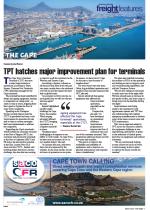Transnet Port Terminals (TPT) is working towards increasing iron ore export capacity out of the Port of Saldanha.According to Earl Peters, TPT executive manager for iron ore at Saldanha Terminals, the port accounts for roughly 96% of all iron ore exports out of the country, mainly through two berths.“The ore arrives via train in Saldanha, where it is off loaded via two tipplers and transferred to the stock yard through a conveyor network. The terminal makes use of dual loading operations, with the two ship loaders working over one berth. The operation is incredibly efficient and very little time is lost when we move from one vessel to another.“It is also possible to load directly to the vessels from the tipplers for higher throughput.”Currently, the capacity of the bulk terminal is capped at 60 million tons of iron ore per year, and the Port of Saldanha has an air emissions licence from the West Coast authorities for only 60 million tons per annum.“Our long-term goal is to grow our capacity out of Saldanha,” said Peters during a presentation to the Transport Forum. “We want to obtain an extension of the Air Emission Licence in Saldanha from 60 million tons to 76 million tons per annum, so as to enable growth and expansion of the iron ore export system, explore a bulk ore solution at Saldanha and expand quayside capacity at the Saldanha multi-purpose terminal to handle an additional seven million tons of iron ore.”He described the multi-purpose terminal in Saldanha and the one in Cape Town as complementary facilities to Saldanha. In Cape Town, the multi-purpose terminal handles about 500 000 tons of manganese at present. The multi-purpose terminal in Saldanha exports both manganese and iron ore and has a capacity of 8.5 million tons.Growing manganese capacity was also high on the agenda for TPT, said Peters.“The goal is to implement the strategy for the long term (2026/27), whereby the Ngqura and Saldanha channels will provide 22 million tons per annum and eight million tons per annum of capacity, respectively.”Cur rently, a ll manganese in the Eastern Cape is being exported out of the Port of Gqeberha, the largest manganese ore export facility in Africa. However, this single berth terminal operation, with its six million-ton capacity, is in the process of being migrated to the Port of Ngqura, where a new manganese terminal is set to be constructed. The move is expected to be completed by no later than 2026. This terminal would have more capacity than any of the manganese terminals have at present, said Peters, adding that it would become the home of manganese exports for South Africa.“At present, demand for manganese and iron ore exports exceeds our capacity, and growing facilities to accommodate demand is important.”He said the immediate focus for 2022/23 was to grow manganese exports out of Saldanha from five to six million tons and to one million tons in Cape Town. “We also want grow our iron ore exports from a base of 55 million tons to export 60 million tons per year.”Earle said while TPT had faced some challenges in recent years at the various multi-purpose and bulk ore terminals, they had also managed to achieve some records.At present, demand for manganese and iron ore exports exceeds our capacity, and growing facilities to accommodate demand is important.– Earl Peters“The Cape Town Container Terminal has seen a surge in volumes.

